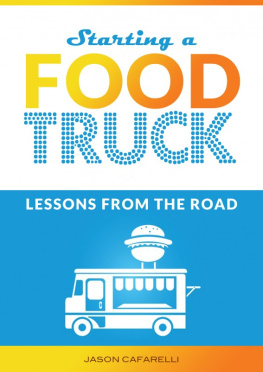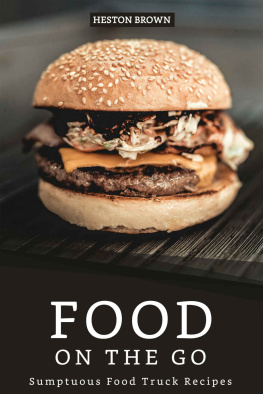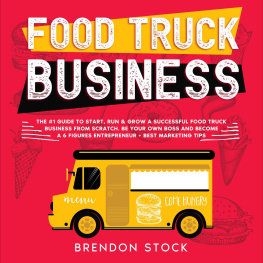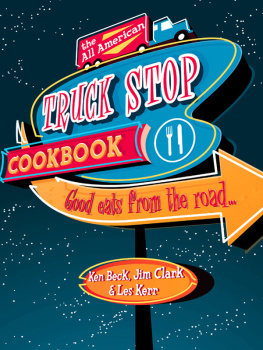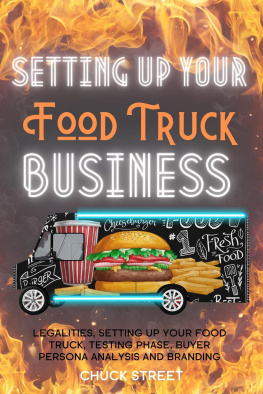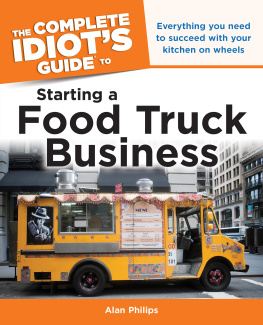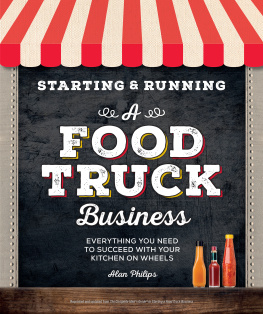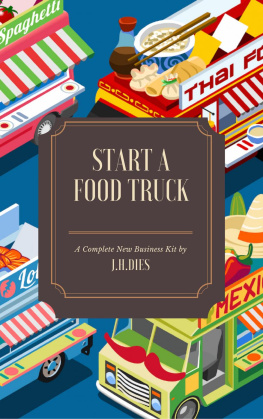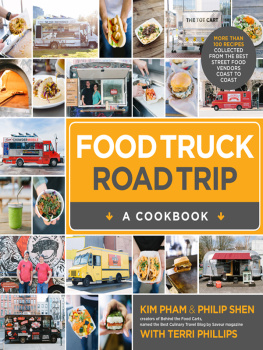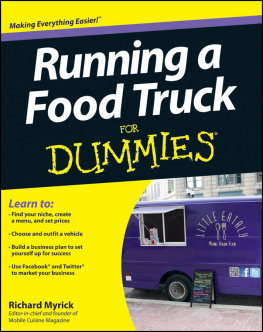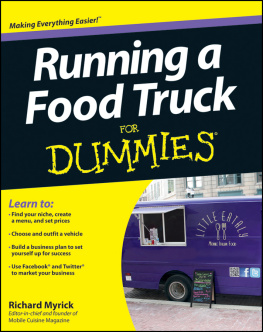How to Start a Food Truck:Lessons from the Road
By JasonCafarelli
How To Start A Food Truck:Lessons From The Road
Jason Cafarelli
Copyright 2014 by JasonCafarelli
SmashwordsEdition
Table of Contents
Food Truck Introduction
March 7, 2012 is a day Iwill not soon forget. It marked the first time working in a foodtruck alongside my uncle, and the experience was an eye-opener fromthe start.
The day beganat 10am by getting yelled at by a stranger, which wasunexpected. His nickname was the King of Roast Beef*." He hadan all black food truck and a grizzly demeanor to match. His menuwas filled with items such as Spicy Angry Chicken, and other foodorders that accurately fit his personality.
On our first day we were inthe crosshairs of the King for parking in a spot he usuallyoccupies. As he rapidly approached our truck, I noticed hisspiked hair and large, bulging biceps. His purpose clearly was tointimidate a pair of unsuspecting rookies.
This is my spot, theangry King said.
My uncle, who is about 40pounds lighter and six inches shorter, took offense to the "King"and his bullying tactics. So my uncle snapped back.
I didnt see your namehere, my uncle said.
That was probably not thebest response. From that point forward we had beef with the Kingof Roast Beef.
Oh, thats how youregoing to act? Thats the way youre going to do it? an evenangrier King said with his hands flailing and now foaming at themouth. You people come up here and you stole the idea. You took myspot. I got regular customers.
Most of what the Kingscreamed at us went over our heads. It was our first day, and myuncle and I just viewed him as an angry, yelling idiot.
But there were severalvaluable lessons that, in hindsight, I wished we paid moreattention to. We were the new kids on the block, for example, andit would have been better to make peace with the big fish as opposeto becoming an instant enemy. That earned us no favors.
Eventually, the Kingproved to be correct. He dominated us with his large group ofregular customers and enjoyed doing so. Some days he would have 35customers at his truck during a lunch hour, while we struggled toget one or two stragglers.
After eight demandingmonths, my uncle seized an unexpected opportunity to return to hisprevious industry. There were many areas of opportunity that laterwill be outlined in this book. But because we got off on the wrongfoot from Day 1, turning the corner of success took slightly longerthan we originally thought.
That is the genesis of thisbook: I want people to learn from my experience, my knowledge andmy blunders. In these pages are the practical andnon-practical tips needed to start and maintain a successful foodtruck.
With properplanning, running a profitable foodtruck is both manageable and obtainable! In fact, anyone can do itas long as you have the passion, work ethic and know how to avoidcertain pitfalls.
My uncle and I had thepassion and work ethic, but situations arose that we neverfathomed. You will learn that in these pages in order to be betterprepared to handle things on-the-fly in this fast-paced world offood trucking.
So if youre on the fenceabout starting a food truck, get off that fence immediately.Food-trucking is one of the hottest industries in the United Statesand presents a huge opportunity.
You can do this! Lets getstarted today.
* Name changed to protect identity.
Chapter 1:Setting A Food Foundation
What am I sellingfood-wise? What can I do different and better than anyoneelse?
These are the questionsthat must be answered early when starting a food truck.
Lets get started. Itstime to establish your food foundation!
The first rule is to havea firm understanding of what you bring to the table. The secondrule is to be passionate about it.
McDonalds, for example, isone of the most popular food chains in America. The company wasfounded in San Bernardino, Calif. in 1940 with a focus onhamburgers and french fries.
Today McDonalds menu haslattes, salads and chicken wraps to stay current. But in sevendecades theyve never abandoned their strong, establishedfoundation of hamburgers and french fries.
Food trucks with a strongfoundation have an advantage in building a large repeat customerbase. There will be times when you need toadapt the menu. But never losing sight of your original purposewill aid immensely in your decision-making process.
My uncle is proudly fromNaples, Italy. He wanted to share his love for cooking via his mostrequested family dish: lasagna. When lasagna didnt initially sell,deli sandwiches, spaghetti dishes and cheesesteak subs were added.The decisions were made on the fly with little-to-no planning.Confidence was lost in his original idea, and the numerous menuitems sometimes overwhelmed consumers.
Learn from this minormisstep. Do not stray from your food foundation. Establish youridentity. Understand your strengths and be passionate about them.This is essential for the success of your food truck.
Now that we set afoundation, lets decide what food items will go on the menu. Goodmenus are an important part of creating a great customerexperience.
Each food truck shouldhave two or three signature items with a few complimentary sides.Coming up with these items should be easy now that youveestablished what you bring to the table. Initially, keep it simpleand add to your menu as you grow.
For example, if youregreat at grilling hamburgers, you can have a classic hamburger, apepper-jack hamburger and a bacon hamburger with fries as a side.If youre selling tacos, you can have fish, beef and pork optionswith tortilla chips and salsa. My uncle had three lasagnas: Aclassic with red sauce, a beef and pork version and a veggieoption. All were served with garlic bread and salad on theside.
Stand behind yoursignature dishes. This is what defines you and how you build yoursuccess.
Chapter 2: Creating a Customer Experience
Here is something everyonecan agree on: There are businesses with excellent customerservice and there are businesses with not-so excellent customerservice.
It doesnt matter if wereshopping at the grocery store, trying to make a flight reservationor having an issue with our cell phone. All of us have recentlyexperienced poor customer service, which comes in all shapes andsizes.
The same is true in thefood-trucking business.
Mastering the art of thecustomer experience is absolutely vital to the success of your foodtruck. Its the second most important aspect next to food quality.The interesting thing is a lot of people know how to cook well inthis business. But very few know how to create a great customerexperience to complement the food.
Great customer service willtake your food truck to the next level and I will show youhow!
Lets get to the root ofthe issue. There are various reasons food-truck operators ignorethe customer experience. Some owners are too busy. Things can gethectic working in a food truck. Owners often are the cooks, aswell, and fail to set aside time to talk to customers. This is acommon mistake that must be avoided.
Some owners are notpersonable. Have you ever had a fear of public speaking? It takes acertain level of charisma, personality and worldliness to talk tostrangers from different walks of life. I promise you working onthis skill will come in handy, almost on a daily basis.
Some food truckers also arenave to think the food speaks for itself. But its the ability tocommunicate your product and create an experience that sets youapart!
To create a successfulcustomer experience, you need to remember five simpleconcepts.
Accessibility
The first aspect isaccessibility. Besides great tasting food this is the top draw forevery food truck. You may be parking at a place where workerscongregate outside the office. You may be at a construction siteparked on the corner. Your biggest advantages are proximity, theexclusiveness of your product and the potential to build arelationship with the customer.
Next page
